Former Tiger Lily Press Director Theresa Khur created the Working Artist Program (WAP) in 2012, and Jan Thomas was the first artist in residence in the program. After her residency Jan was asked to join Tiger Lily’s Board of Directors as the Education Chair, where she developed a comprehensive education curriculum that was added to the existing class framework. Recently Maureen George was able to catch up with Jan to see what she has been up to and talk about her experience with the TLP Working Artist Program.
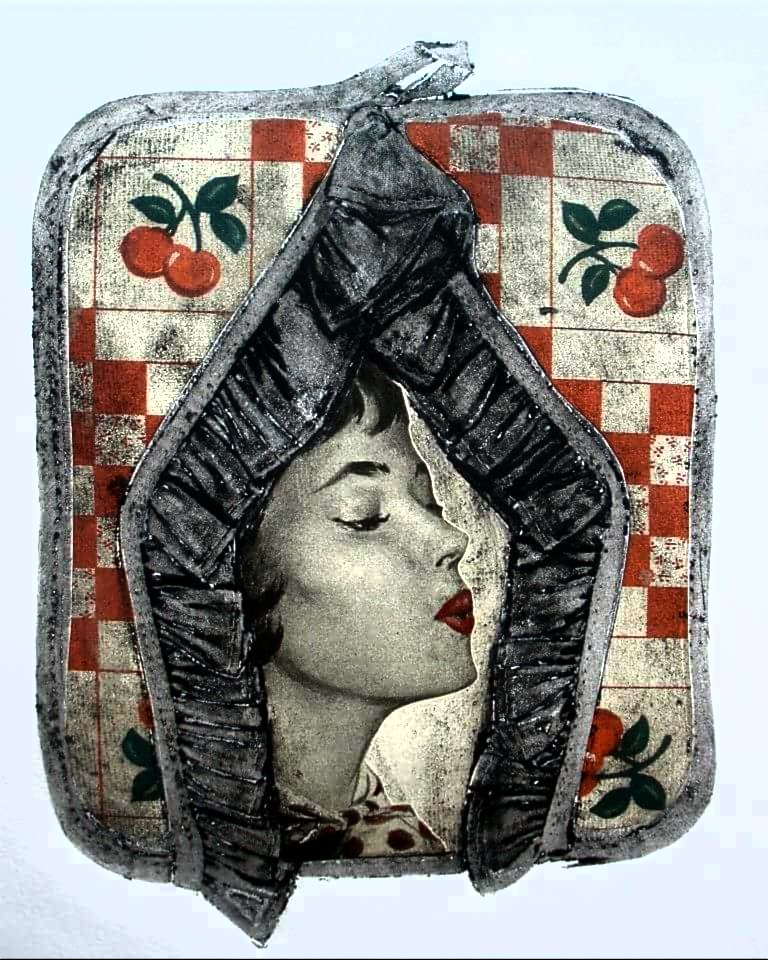
Cherry Lips
MG: How did the Working Artist Program affect your work and your career?
JT: I can say that it was VERY impactful. I was an arts educator, and I taught up until 2000. After I retired, I set a goal for myself to have a solo show every three years. I was on target, and had had a number of solo shows. The first one was called Lineage, followed by Lost Art of Laundering held at The Carnegie in Covington, Ky. and the third was Crossroads held at The Fitton Center in Hamilton, Ohio. I was working as an eclectic, assemblage artist with a heavy, heavy, emphasis on manipulating fibers and fabrics. I’ve been a long-time collector of ephemera and often these items end up in my work. I’m not above diving through a dumpster if I think there’s something good in there when an estate is being sent to the curb.
Susan Naylor, longtime TLP studio manager saw the Crossroads show. She contacted me and asked if I would be interested in doing the Tiger Lily Press artist in residency. I said “But, I’m not a printmaker”. She responded “Well, we’re curious to see what happens when a fiber/assembly artist meets a print press”. That’s how the residency came about. I think I was one of the earlier artists in residence at Tiger Lily at its’ new home in the little school house at Dunham Recreation Center.
I am not at all a traditional printmaker. I’m not interested in creating editions, or becoming a finite printmaker of a particular technique. I’m more interested in what the prints can do for me to further what I have to say in an assemblage/fiber format. Almost all of my prints read as assemblage work. Many of them are layers of prints that have been pieced, sewn, stitched and/or chine colléd and exist as singular pieces of art. I don’t know that I started out knowing I was going to work this way, but when I started printing, that’s what happened.
One of my commitments to Tiger Lily was to produce a show during my residency. The show was called Red Hot Pots. The entire show was based on a pair of vintage pot holders that I found in a thrift store. The potholders became collagraph plates, with each print chine colléd using vintage fabrics and images of women from 1950s Life magazines. The concept of the show was that “there was more cookin’ in the kitchen than dinner.”
MG: Were those the actual images from the magazine, or did you use a polymer plate?
JT: I did a little bit of both. I wanted to preserve the magazines, so I made copies of the women on a high-quality cotton rag paper using my printer. On most, I used the vintage fabric, unless the fabric was special to me or I only had a small piece of it. In those cases I also copied the fabric. Red Hot Pots was shown at a vintage gallery/shop in Cincinnati called Nvision. Afterwards the show travelled to the Stuart, Florida area and was shown at a gallery called Art Mundo. Both were very successful.
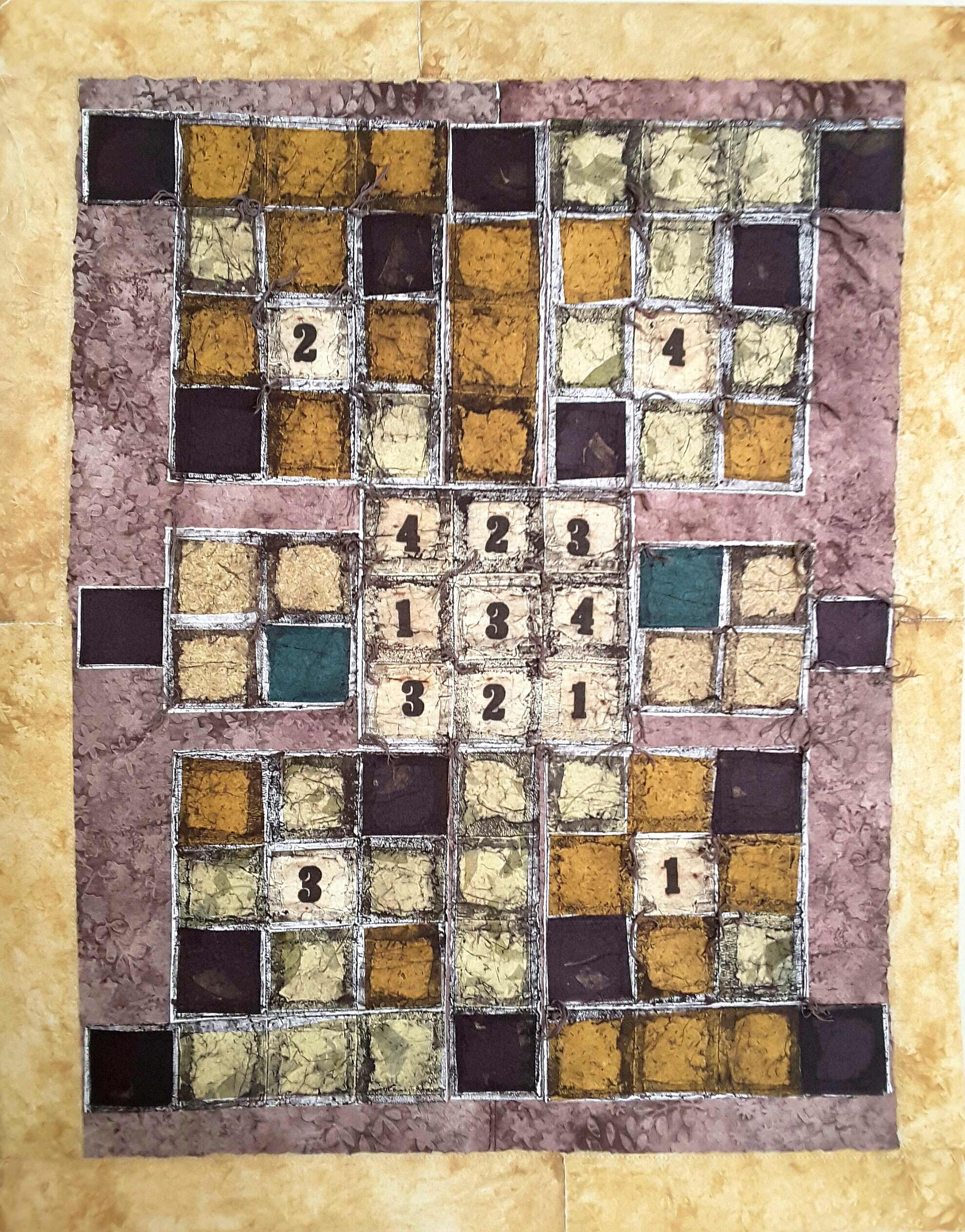
Coded Quilt
After my residency at Tiger Lily, I was invited by artist, Ken Swinson to tackle a two-week residency in Old Washington, KY in a 1790 log cabin were I lived and printed. Quite the adventure! I was influenced by the history of the surrounding area and produced a printed paper quilt as a reaction to the historical use of quilts as a form of communication during the time of the Underground Railroad.
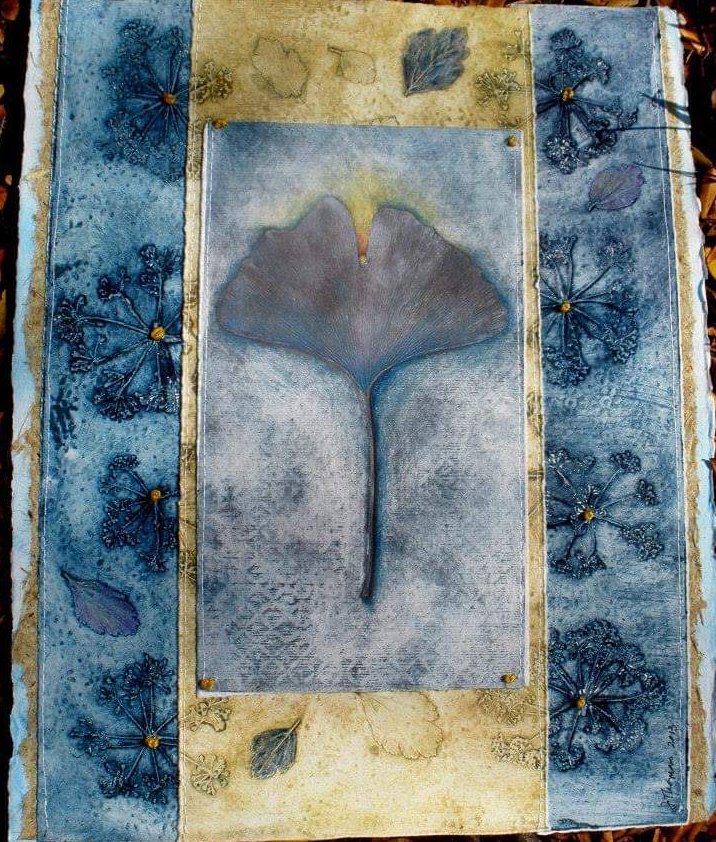
Temple of Memories
I became a TLP member and kept using the equipment and the studio space. I went on to produce works for another show which was called Temple of Memories. That show was shown in Harrison, Ohio at The Coffee Peddlar Gallery. The show was based on collagraph plates of gingko leaves and textural fabric plates. Every print in the show had at least three or four collagraph prints involved in the final piece. Prints were manipulated, cut, assembled, sewn, and embellished with colored pencil and gold paint. The concept of the show was based on the relationship of the gingko tree to memory. The last thought of the day was represented by delicate colored pencil sunsets enhancing each printed leaf. The show was dedicated to my uncle and a good friend’s father. Both died of Alzheimer’s. All the proceeds from the show went to the Alzheimer’s Society.
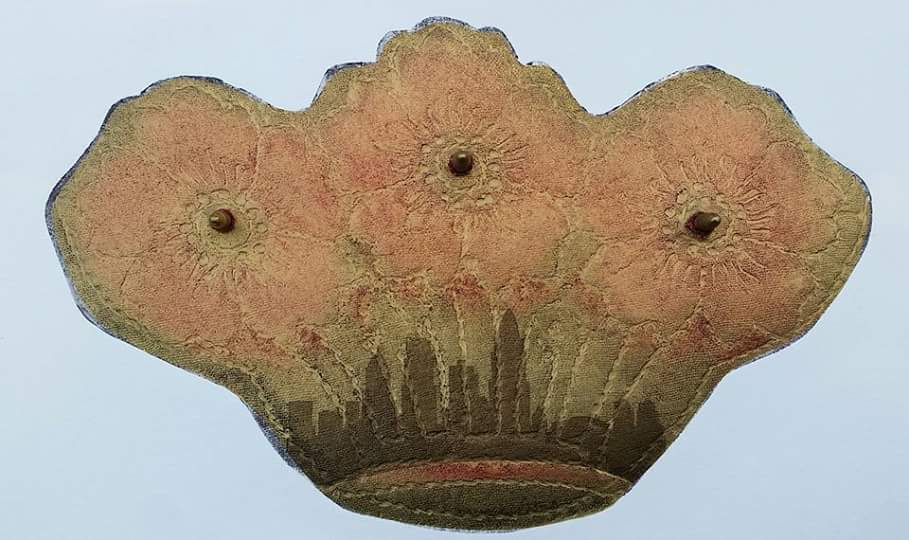
Boom
I continued with printmaking still doing assemblage prints — pieces that spoke about social issues. Boom is one of them. The origin of this print is a vintage flower stitched doily which became a collagraph plate. The silhouette of Cincinnati printed on gold paper was chine colléd on during printing. What seems to be a piece offering homage to the Queen City ( note the crown shaped print) and the festive end of summer fireworks really has a more complex message. The bullets piercing the print reference the under belly of our city and gun violence.
I was out in an antique shop and I came across a vintage card basket. These handmade baskets were a domestic craft form with patterns and instructions found in the back of women’s magazines back in the mid century. Women saved greeting cards and followed the patterns cutting cards into multiple pieces, assembling them with either a buttonhole or crochet stitch. I bought the card basket. I just loved it! This was an opportunity to take my assembled prints to a dimensional format. My thought was “Well what if I took my prints and used them dimensionally. I could print an edition — this is the closest I ever came to printing an edition — of images that could be cut into a pattern shape and stitched into three-dimensional vessels”. I thought, “maybe I could put these pieces in the Ohio Designer Craftsman show because it’s a basket as well as prints.” The first time I submitted a piece, it was accepted, and there’s nothing like positive reinforcement! I liked the process. It combined printing and hand stitching. I loved exploring the endless possibilities of shapes. Creating dimensionally from my prints became my focal point, and I am still exploring the possibilities.
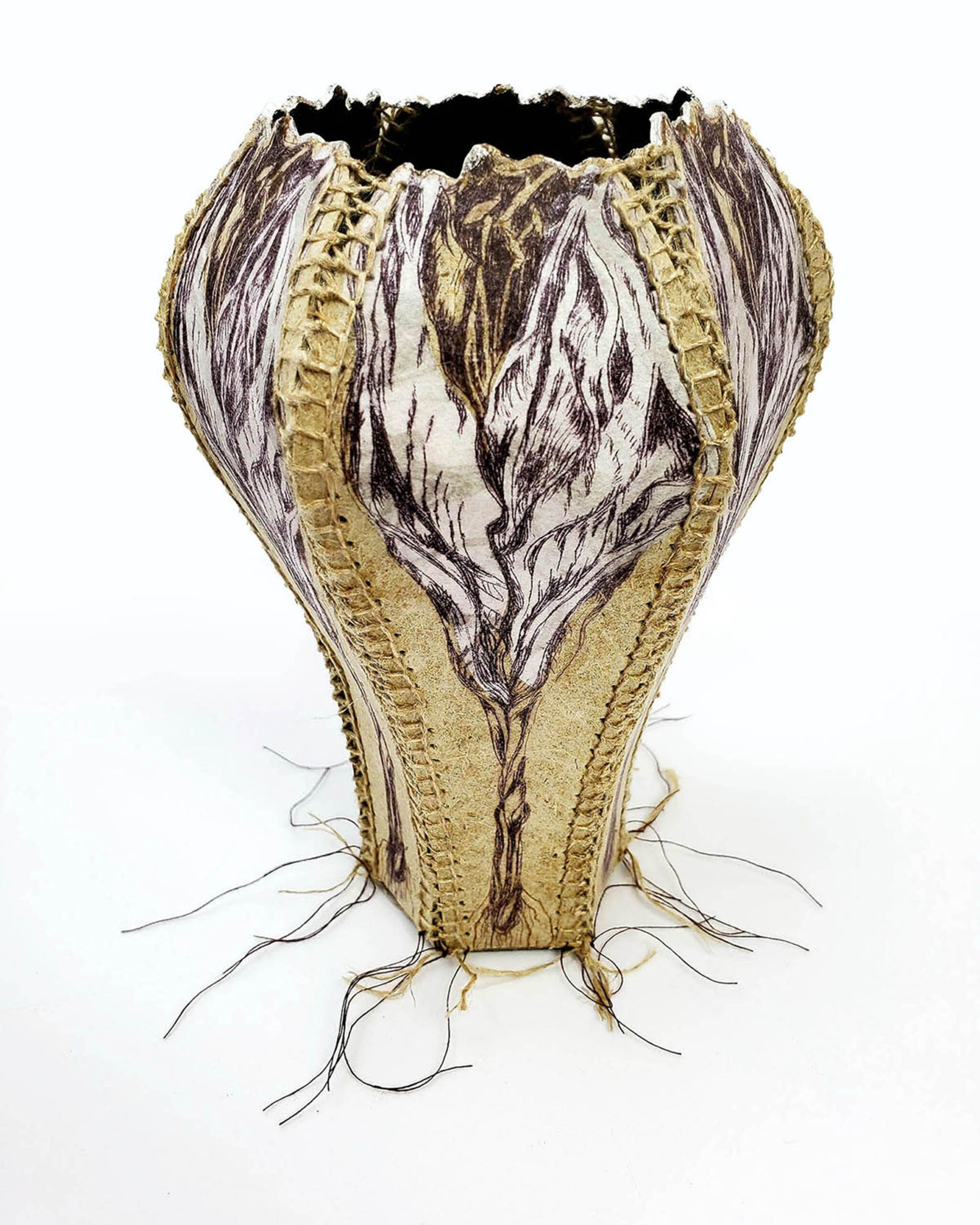
Savitus
These pieces have been really well received. They are crossover art pieces because I can enter them into printmaking shows as well as fine craft shows. I got involved with the National Basketry Organization after I entered one in the national call for entries. I think it was their Members in Print show. And lo and behold, it got in! I have been fortunate to have pieces accepted every year. Savitus is my latest piece shown in 2020 in The National Basketry Show.
These baskets are very time consuming. I have two themes that I’m working with. There is my Woodland Series where I am drypoint etching on Plexiglas, drawing plants and plant like imagery using my own garden for inspiration.
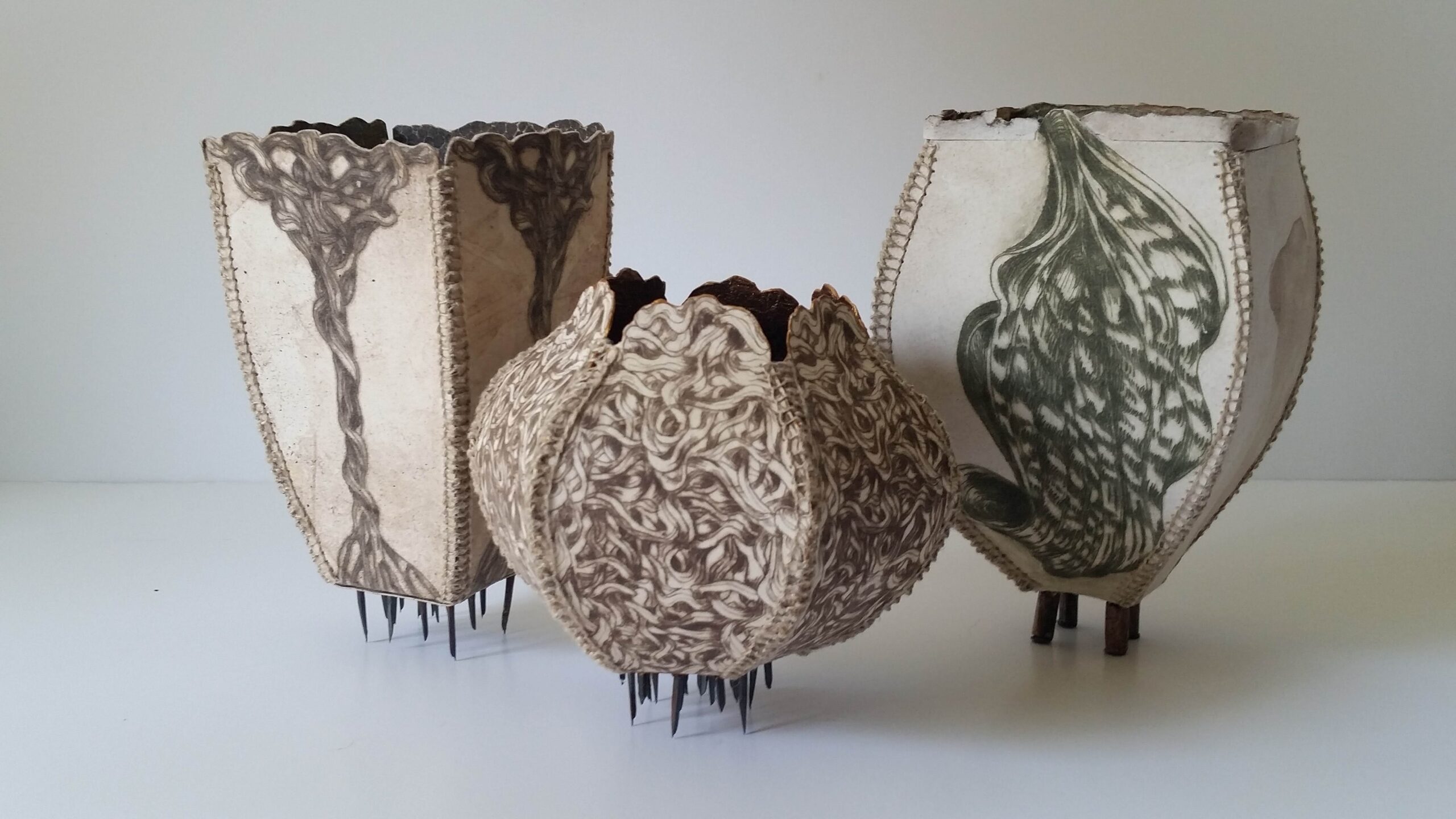
Woodland Series
The other theme is pattern oriented. These are collagraph plates. The embossed textures look like fabric. This is my Travel Series because the patterns relate to places I’ve been. For instance, Siena is printed in the Tuscan earth tones indicative of Italy and the pattern reminiscent of heavy brocade fabrics. Morocco looks like geometric Moroccan tile patterns.
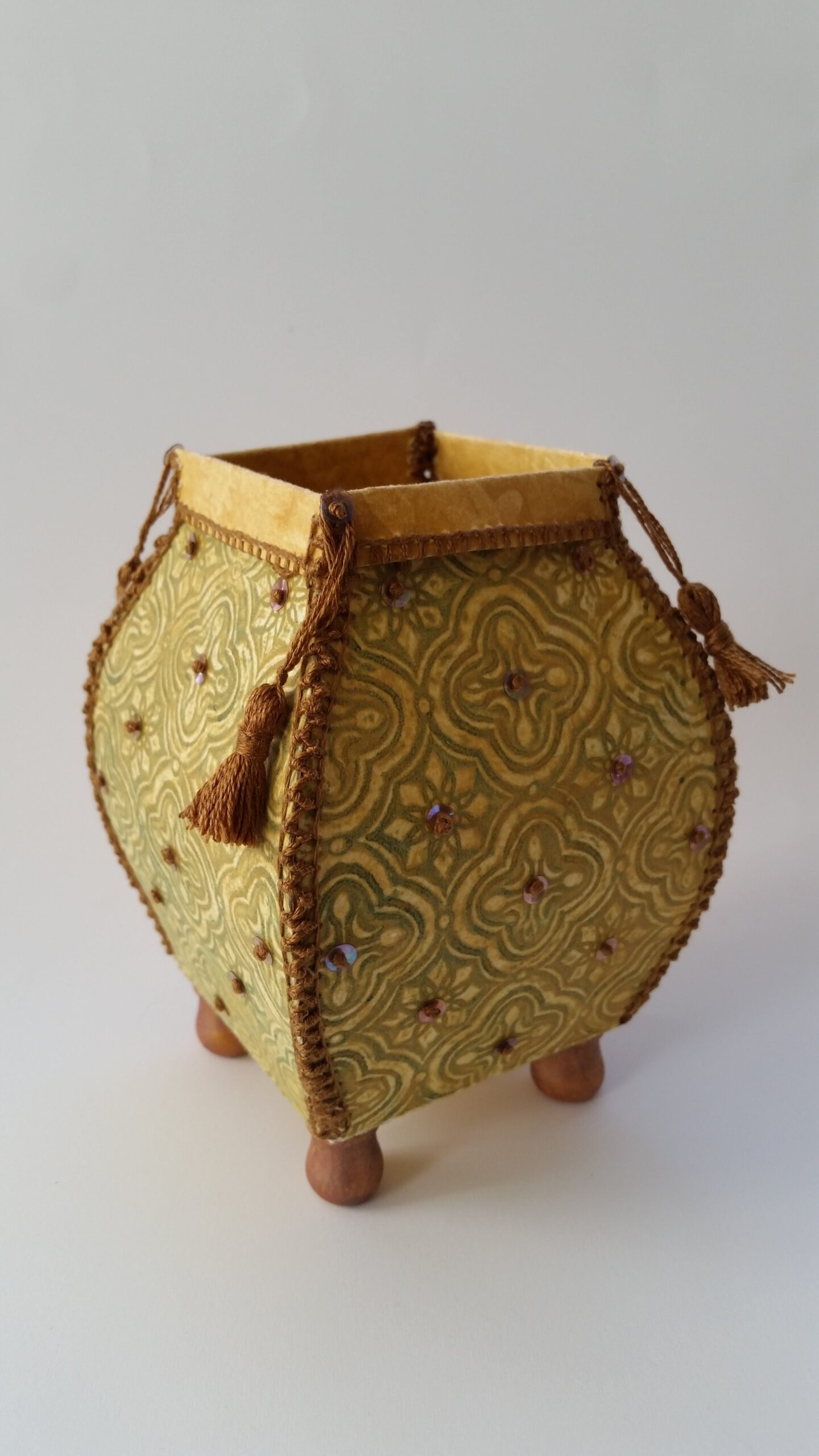
Morocco
MG: Did you find those fabrics in your travels?
JT: No, and not in all cases are they actual fabrics. It’s about half and half. Some of them are embossed papers that I’ve found, and, no, they didn’t come specifically from the places that I traveled to. They just were reminiscent of those places. I find that I’m lagging behind on the travel series because it doesn’t capture my interest as much and covid brought travel to a halt. I like the Woodland Series. Drypoint on Plexiglas takes me back to drawing , and I had been wanting to do that.
The printmaking part of my life came to a crashing halt with COVID. I set it aside — although I had two vessels that I was finishing up during this last year. I went back to assemblage art and bookmaking, which I like, and have done throughout my career. Again, the bookmaking is not traditional. These artbooks are assemblages of things that I find, and that I’m curious about. The other thing I did was to commit to finishing projects — things that I had in the studio once — started, in some cases, 20 years ago that I had lost interest in, or maybe I didn’t know what its direction was at the time. So those became my focal point. I’m still finishing up a lot of work that’s been waiting for me all these years. It’s been fun to revisit and try, in many cases, to rethink whatever it is that I originally thought I was doing with the work. In some cases, I have altered direction from what I thought it was going to be years ago.
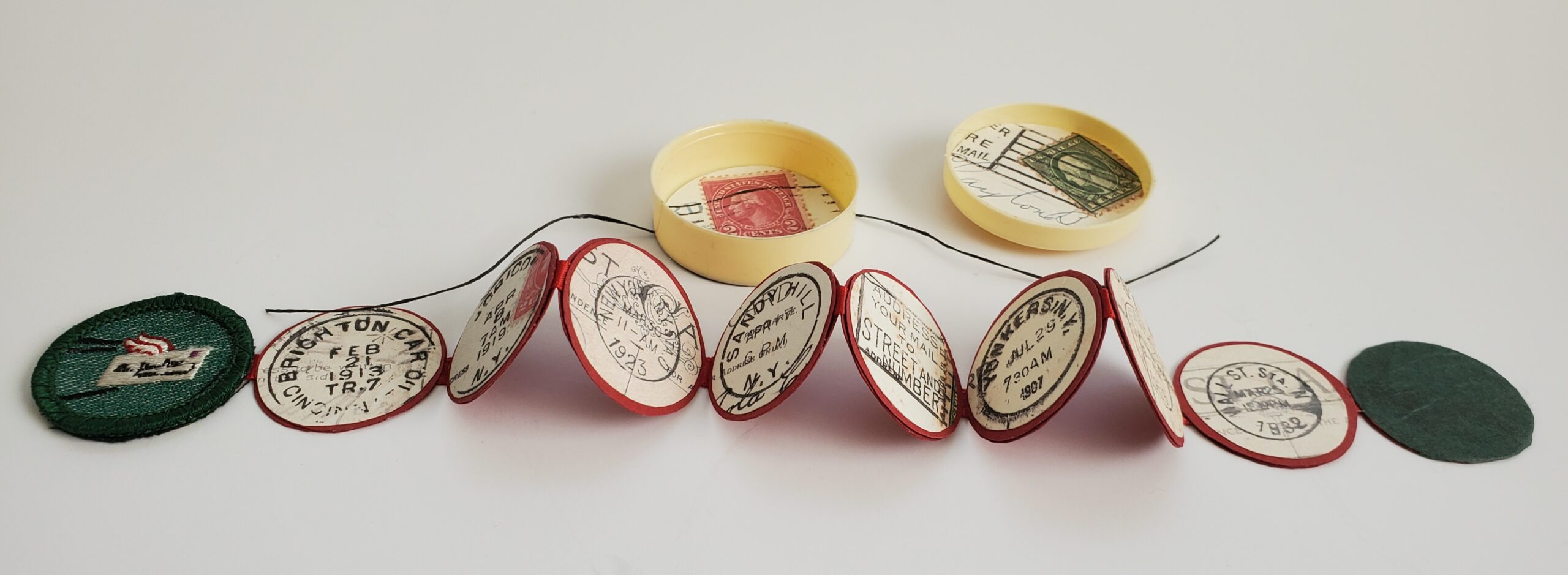
Cancellation
MG: Are there samples of that in the images that you sent to me?
JT: Let’s see. A number of them were books that I was (re)finishing. I think I sent you the little circular button book which is going into the CBAS Off Ludlow Gallery show in the Old Post Office off of Clifton, opening in June. The cover of that book is a Girl Scout Pen Pal Patch that I earned when I was about 12 years old! I told you I don’t get rid of anything! It’s been kicking around my studio forever! Suddenly it became a book! The pages of the book are cancelled stamps from a collection of old letters that I have. This book is about connecting and communication. So that’s an example of something I’ve finished recently.
Another book which I am really pleased with the outcome is called The Gray Line. It is a rewrite of the history of Mt Vernon using a vintage postcard folder of Mt. Vernon rooms. My version includes the silhouette of slaves who were also present in the rooms.
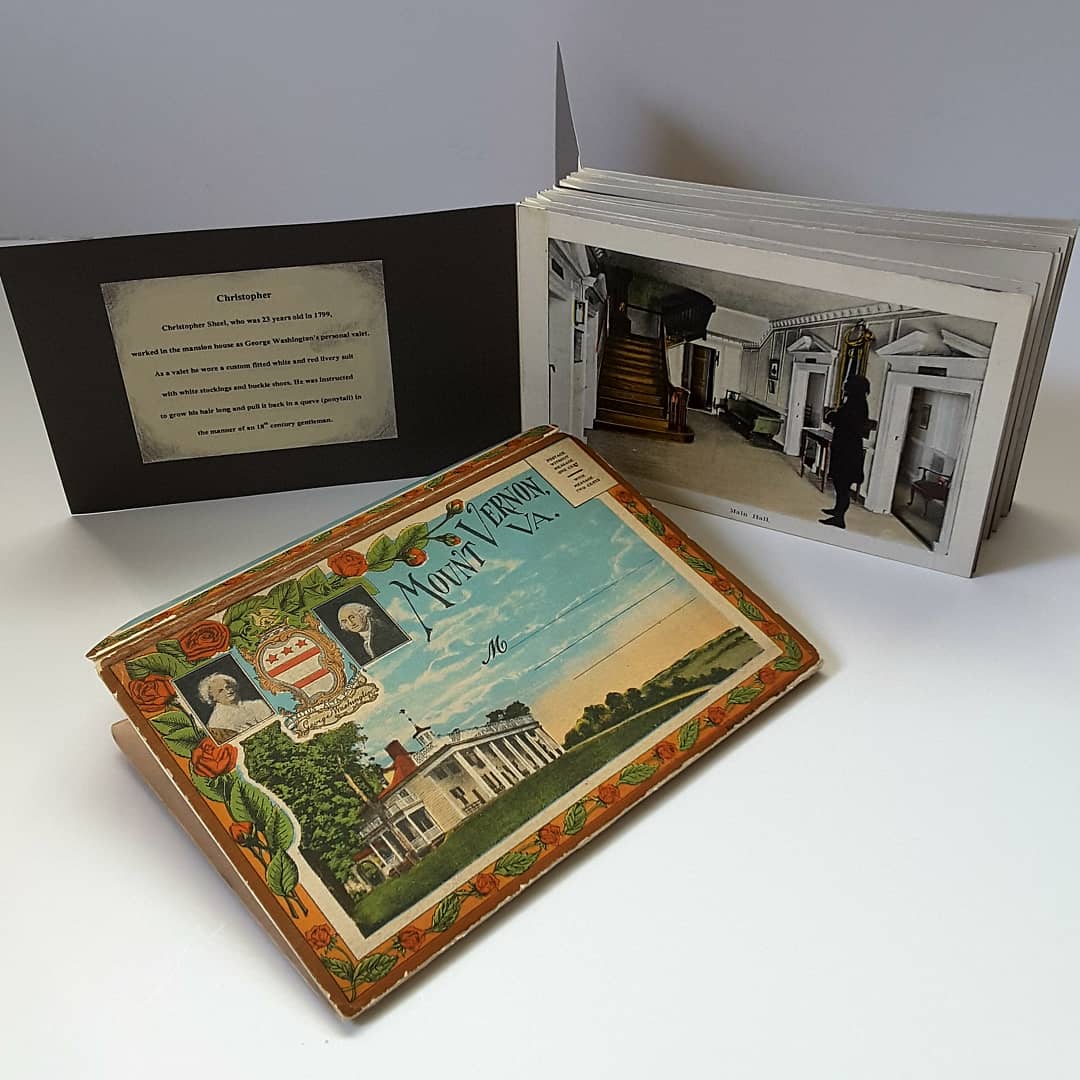
The Gray Line
I have an assemblage piece that’s going to go into the SOS show. It’s a piece, again, that I started maybe 15 years ago. The name of this work is Monumental Discovery. When you look inside, I have mounted a graphic print of The Universal Declaration of Human Rights that I found in a 1950s magazine. I just finished it recently. I can’t even tell you what the original intent was although that article was always inside the box. My resolution encourages all of us to examine this important 1948 document and access our progress as a people in the fight for basic rights and freedom for all people.
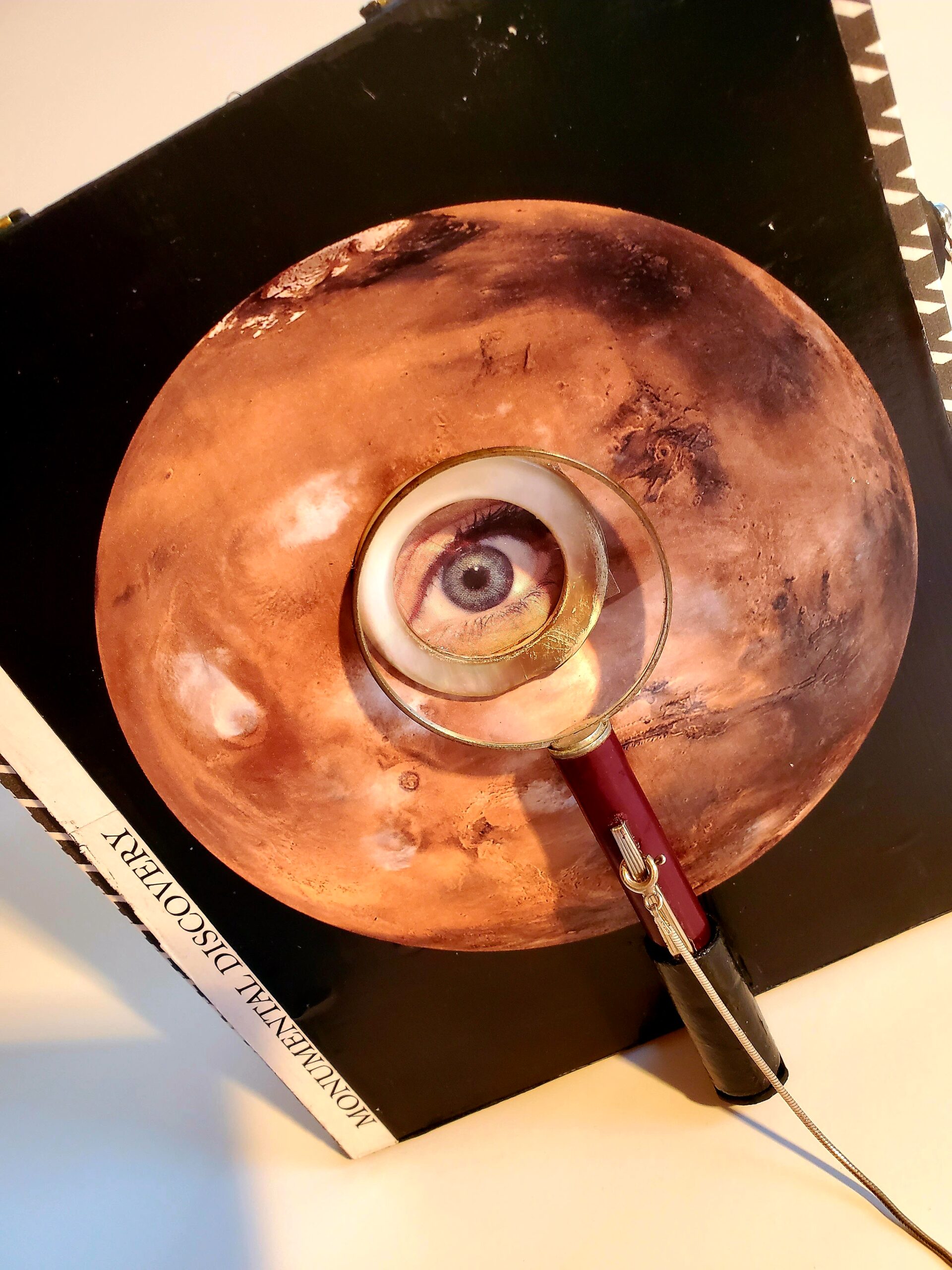
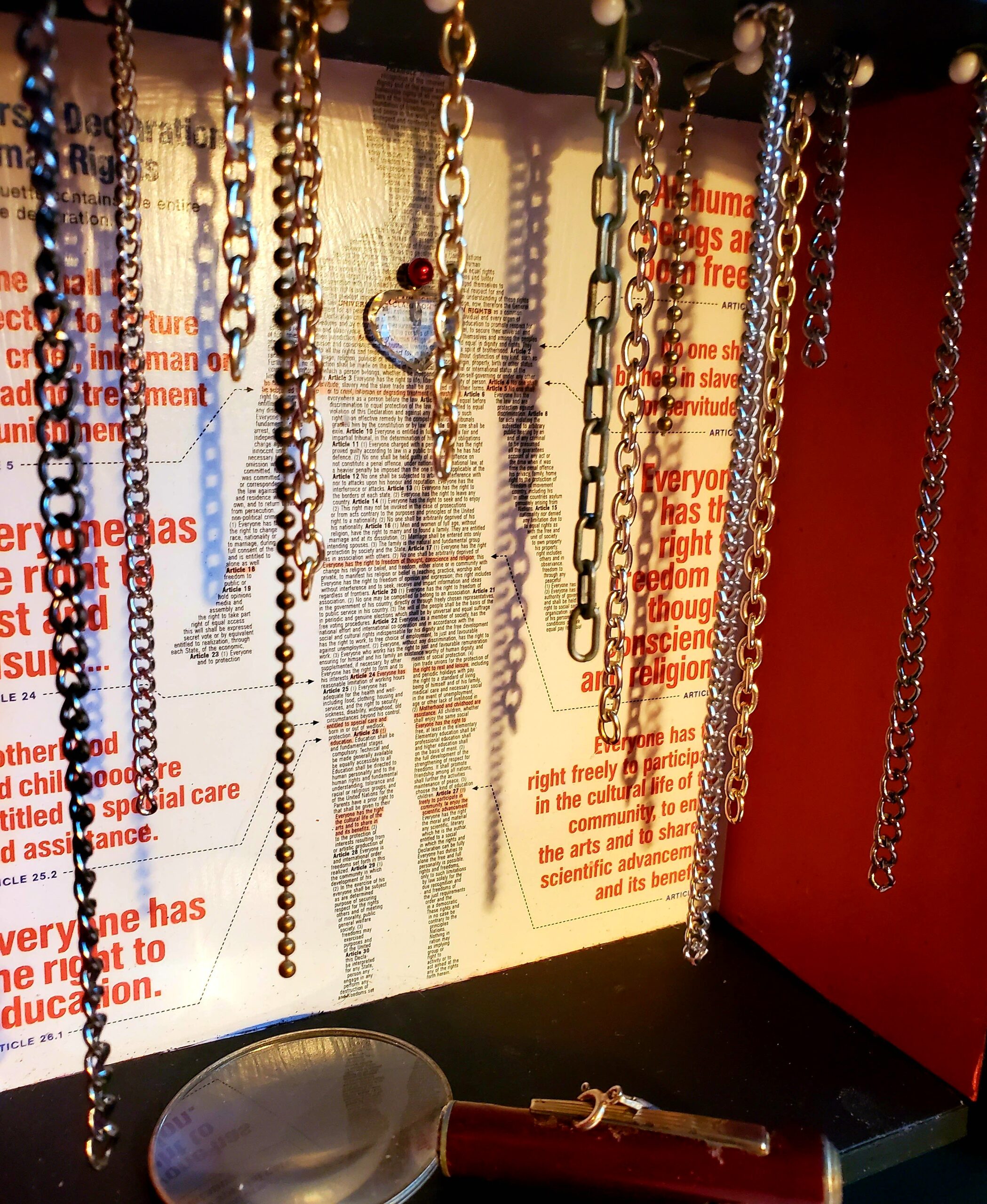
Monumental Discovery
I’m very active in Art for Artists. I have been the coordinator of all of our major shows. We did the Womenworkbooks show in 2014. This was a collaborative artbook show three years in the making. Hanging Out was repurposed clothes as social statement art. The latest show is part of Kennedy Heights Arts Center’s Collective Impact Show. Our piece is called The Walk.
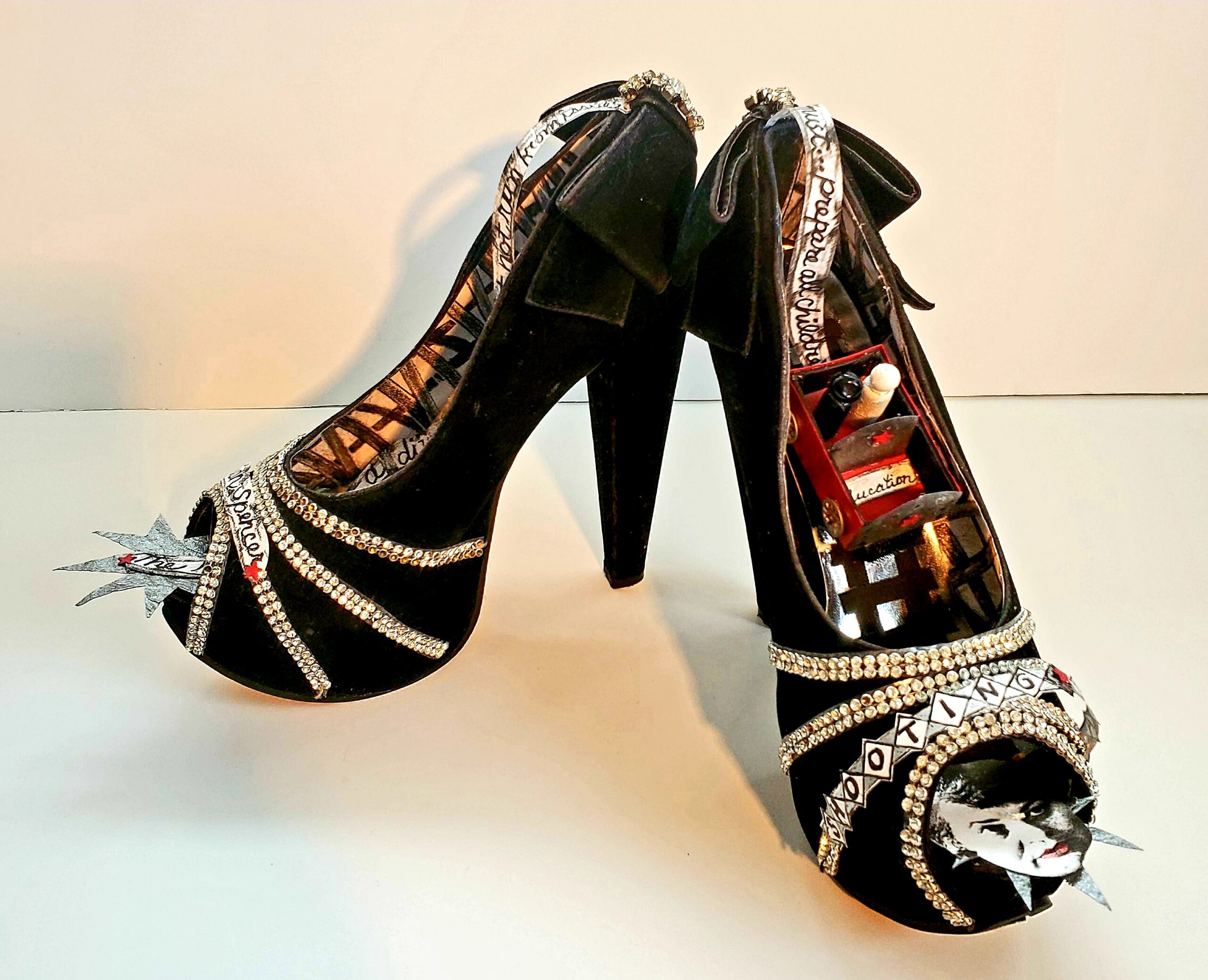
Shooting Star
This show is based on women’s shoes which have been altered. Each pair of shoes entered is a memorial to a particular woman in that artist’s life who was significant. It ranges from our mothers to local, national and international figures. The consolidating fact is that all the shoes that were used had to be black, and the statement about the particular woman had to be contained within the inner soul of the shoe. It’s very tricky working with a group especially when you’re the organizer. All of our work is individual, and yet we find ways to bring it all together as one total statement.
MG: That’s amazing! That answers the question of what you’ve been doing since being the WAP artist. Are there any other projects you’ve been working on?
JT: Actually I am in recharge mode. I have learned that after an active creative period, I need to be patient and wait for the next wave of energy and ideas.
MG: What did you take away from your time as the artist in residence at TLP?
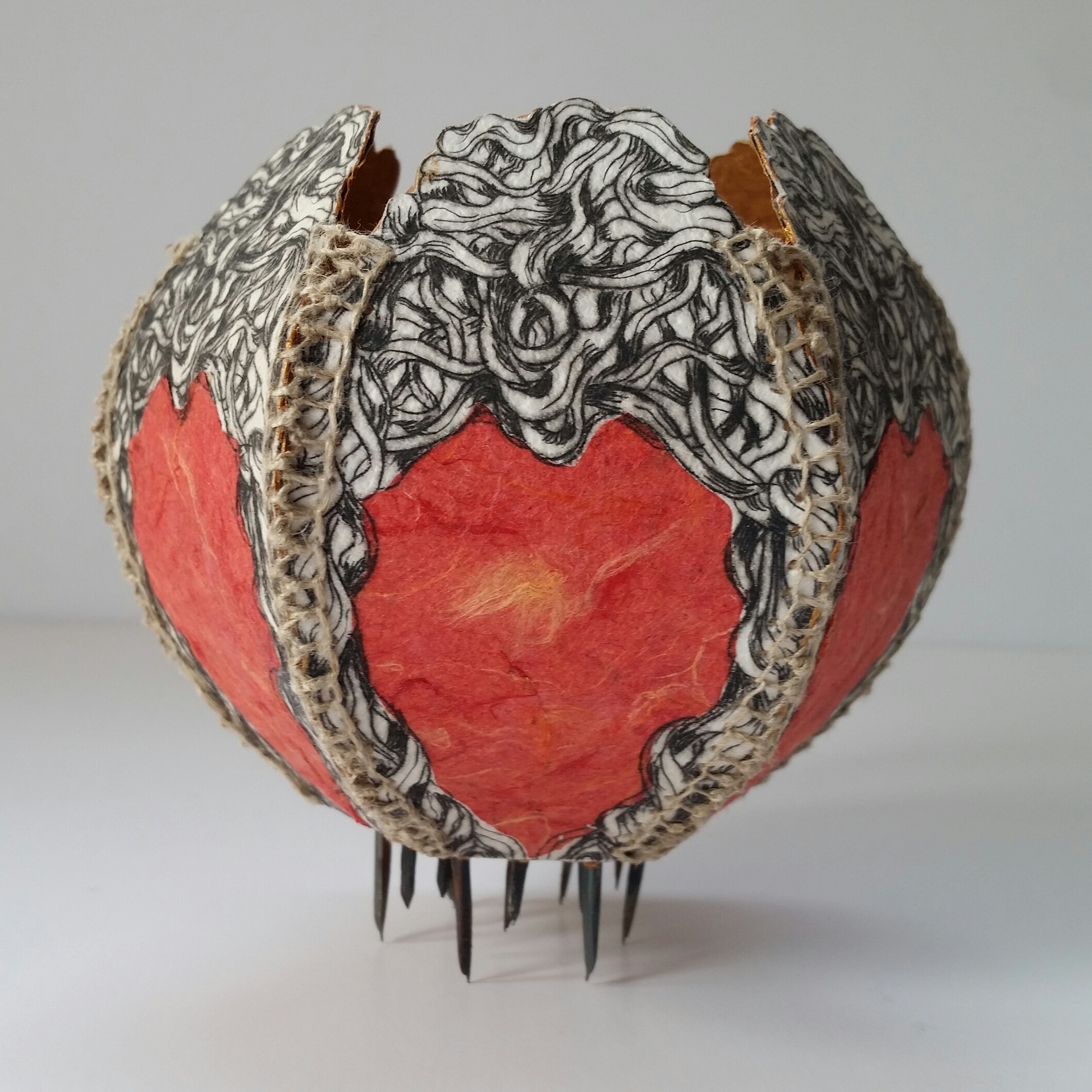
Blood Braembel
JT: Well….it’s certainly broadened my knowledge and allowed for different opportunities for creative expression, adding printmaking to my wheelhouse. And ultimately, it led to my using my prints to make the dimensional vessels. I just wasn’t satisfied being a traditional printmaker. That was not the joy for me. Many years ago I was a weaver. That process involves design, planning and prep work, which was exciting. However, I found the making tedious. Now, I have reversed the process in that I don’t really know how the piece is going to look when finished. The art takes lots of twists and turns as I go through the process. That’s why traditional printmaking doesn’t really interest me — For me the fun is, the challenge is, in not knowing how it’s going to end up. When I start out on a piece, what keeps me engaged is the not knowing.
MG: Yeah, I can identify with that — exactly. I went away from printmaking for years, and then I started doing monotype and liked it so much better. It’s more like painting or sculpture in a way.
JT: Right…you don’t know you’re done until you’re done.
MG: So what was the best part of your experience at Tiger Lily?
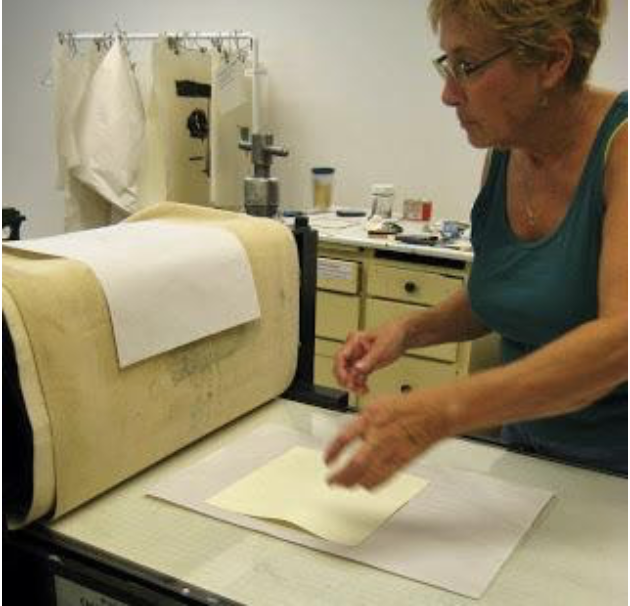
Jan working at Tiger Lily
JT: Having such a wonderful, well equipped studio to myself. I was like a kid in a candy shop.. Everything was there and available to me, and I had the luxury of experimenting since I knew very little to begin with. It was having the studio and free reign to experiment. The residency really led to changing the course of my artistic career (with the vessels). I’m 75 years old, and I’m peaking now, feeling satisfied in my art career — finally — after all these years!
MG: I think you touched also on how the pandemic has affected your artwork.
JT: Art for Artists was a lifeline. We went to Zoom meeting format for the year. We were able to pull off two collaborative statement pieces during a pandemic year and that was due to learning how to Zoom. It was a way to continue to communicate for many of us who were stuck at home. We were able to talk and create and share. I would say that the impact of COVID was positive in terms of my art life. I finished up a lot of pieces that had been hanging around. The pandemic caused me to slow down, reorganize my studio, my mind and my priorities. It did bring my printmaking to a halt and I seem to be taking this time to rethink my printmaking direction.
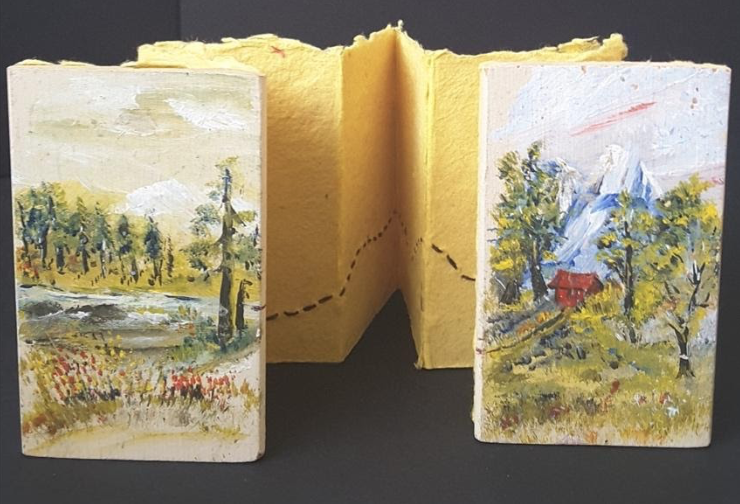
Home
MG: I feel like I appreciate it more when I actually am talking to people other than just my husband and I or our neighbors outside on a walk.
JT: I agree. I thrive on the exchange of ideas with my artist friends.
MG: What upcoming projects are you working on?
JT: What’s next? Good question! I have a couple works that I’m finishing. I keep a visual Journal or diary of what I’m doing. It’s notations of everything that I’m working on, ideas that I have, what I thought it was going to look like, and how it ended up. If I go to the last page that I wrote in….I can answer your question. The last vessel I did was called Savitus and that was in the national basketry show. I really wish I’d been able to keep it longer, but it’s sold out of the show and it’s gone. My next idea…now this doesn’t mean that it will happen, but at my age, I think I’m about ready for a retrospect show. I haven’t done a solo show in a number of years, and I think it’s time.
Also, I am working on a book called Saint Theresa’s Road Trip. It’s in an old Rand McNally Atlas that was my Dad’s. When he died, a neighbor had made a contribution to Saint Teresa, The Little Flower, in my father’s name. I’m not Catholic so I don’t know much, but she was the Saint of the Little Flower. My Dad was an avid gardener. So Saint Teresa’s going on a road trip to every state in the union, and she’s visiting shrines dedicated to her and gardens. My friends have given me all their Catholic prayer cards and there is a lot of territory to cover in the atlas! It is keeping me busy. I have to research where the shrines are in each state, Then I have to research the roads to get there. Then it all gets assembled on the page — glued down — and I’m off to the next page.
MG: Is there a shrine in Ohio?
JT: Oh let me see. well, what I found is in Cincinnati — I’ve known about this fabric store for many, many years — it is called Saint Teresa’s Treasure Trove (of textiles) and the last location for this shop was at The Pendleton, So I thought for Ohio, I would use that.
MG: That’s so perfect!
JT: This is all just generating in my head now. I’m just having fun with it. This is another book that I started years ago and now I’m back working on it. Maybe this has to do with my age, but I feel a need to tie up loose ends. You know don’t leave anything unsaid. Get it done.
MG: So where would you like to have your retrospective show? Would that be in Cincinnati?
JT: Yes, it would be in Cincinnati. I’ve shown at Kennedy. I’ve been at the Fitton. I’ve been at the Carnegie in Covington. Well gosh! I’d love to be at the Art Museum, but that’s not going to happen. I don’t know where I would show. Perhaps, somewhere academic because I am an arts educator at the core.
MG: That’s wonderful!. OK! The other question I had is, when you pulled out that Journal, I was wondering if you could send a couple pages for the article? A link to this article is going to be in our member newsletter so it will be on the website, and members and others on our email list will be really interested in seeing that part of your process.
JT: Sure. I have always kept a journal of writings and sketches. Nikki Mechler, who I met at TLP keeps a really extensive working Journal of progress. She was there working pretty regularly when I was the resident, and I loved her journal, and I just started keeping mine similarly. It’s not something I write in every day, but I’m pretty religious about putting down when I start a major project, what I think it’s going to be, and then what it finally becomes and what happens to it after it leaves me.
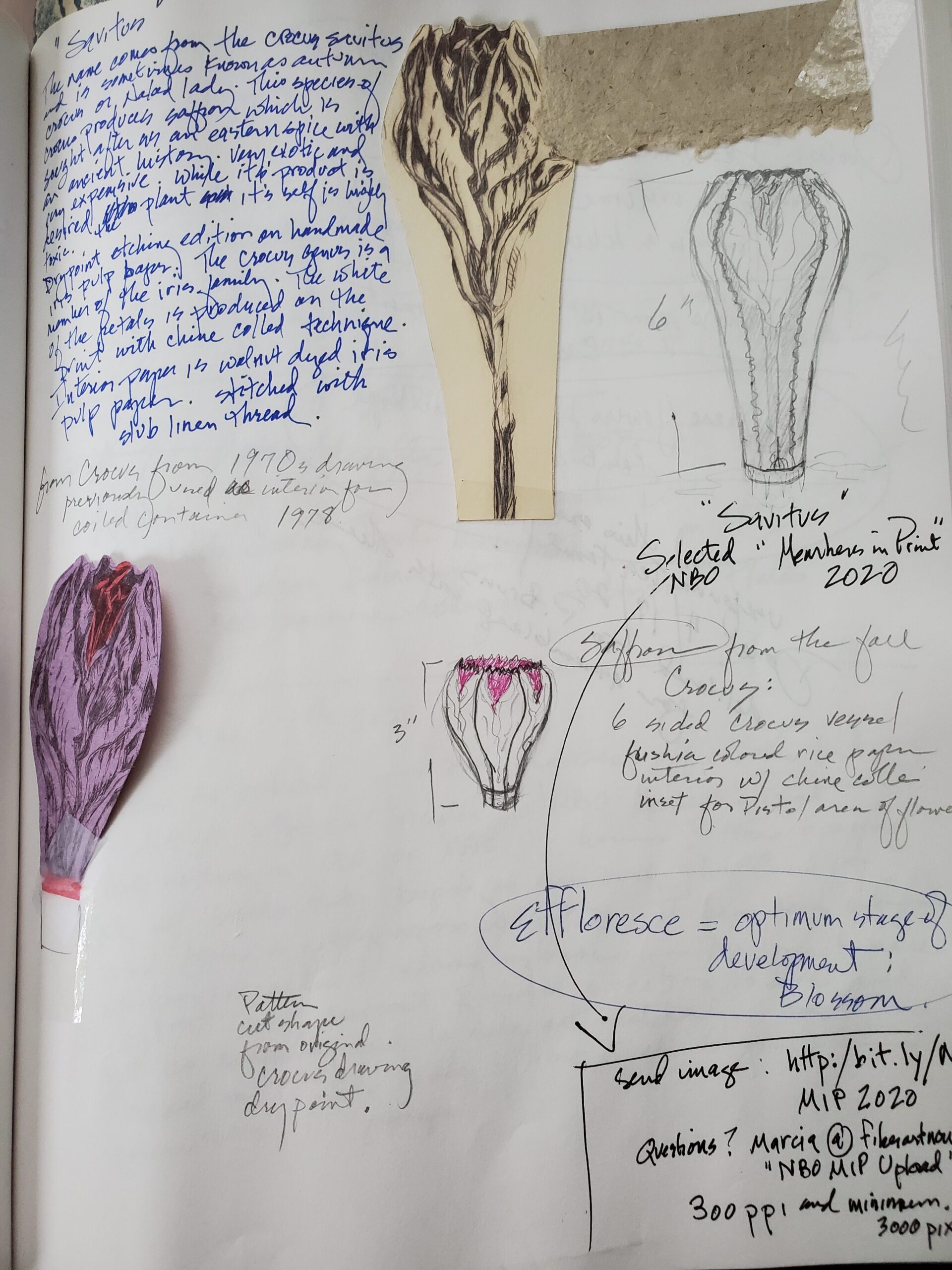
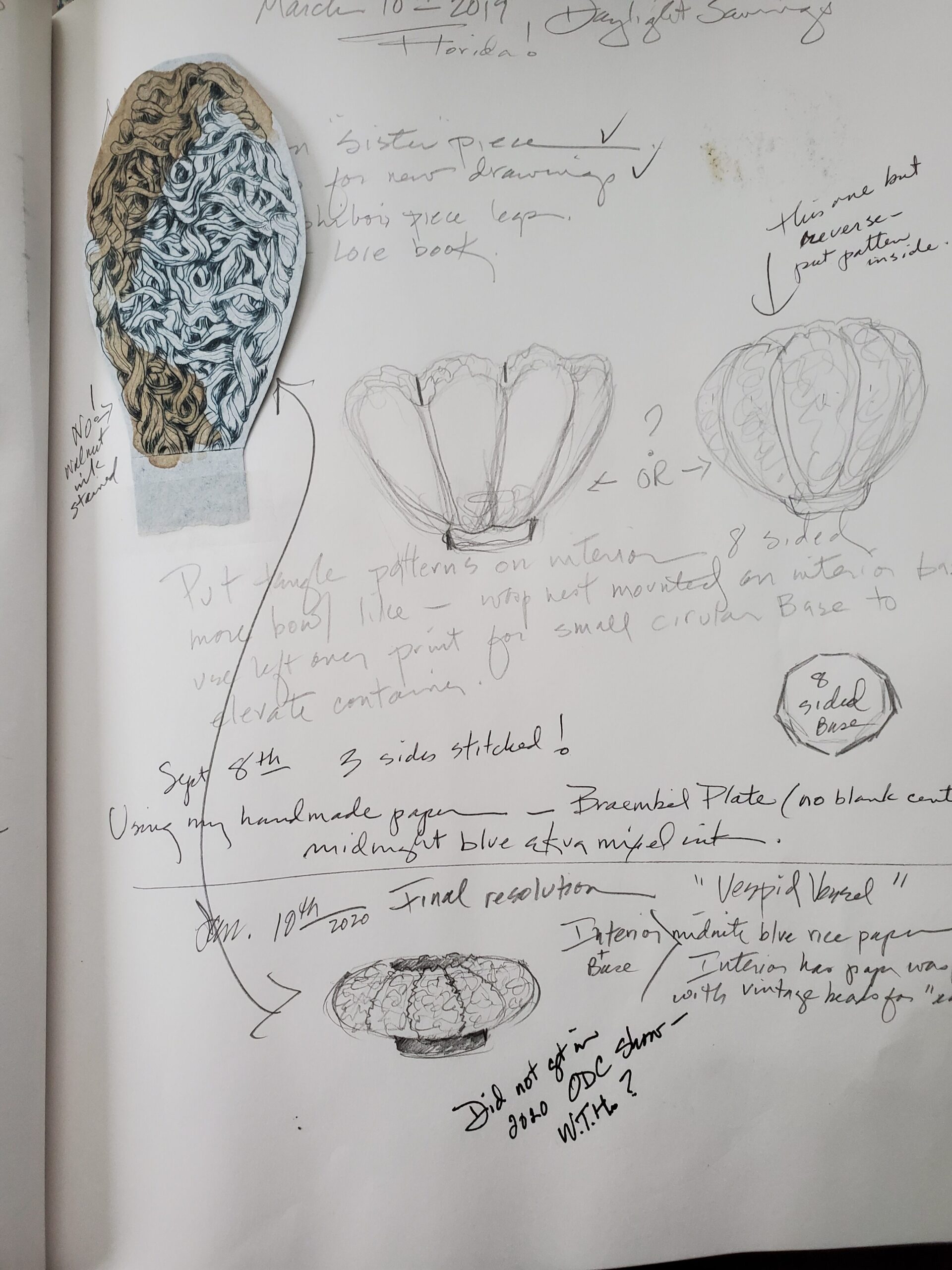 Journal Pages
Journal Pages
MG: It’s wonderful! What a great thing to have! That would be perfect to have in your retrospective too.
JT: Well that’s a thought.
MG: Thank you for doing this, Jan. I know everyone will be interested in reading about you and your work.
JT: Thank you. Tiger Lily really spun me off in a new direction. I probably would have stayed with assemblage and fiber. I would never have done the vessels. They turned out to be a wonderful opportunity in my art life — very gratifying.
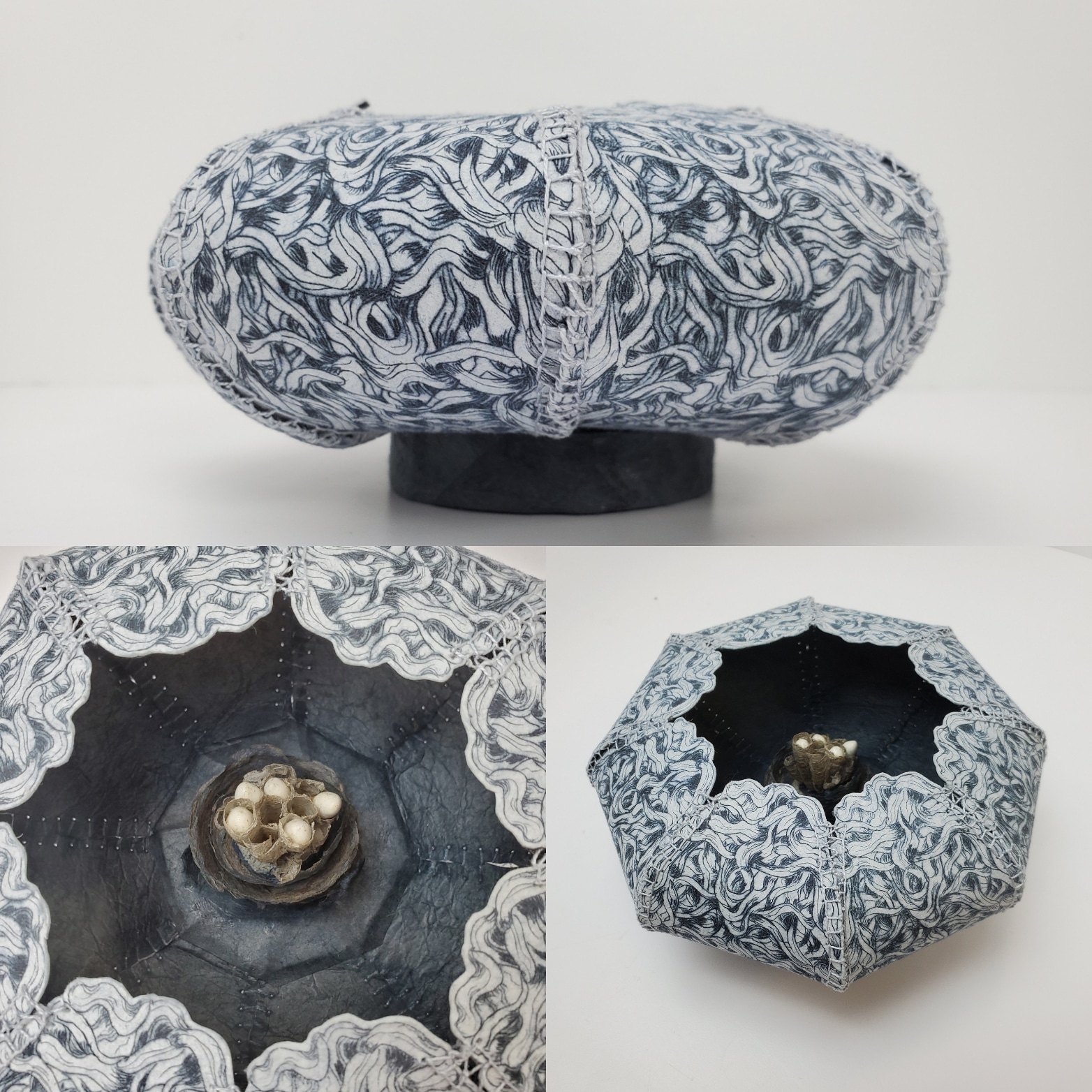
Vespid Vessel
Examples of work from Jan’s residency are on the Tiger Lily Press website at https://tigerlilypress.org/photo-galleries/nggallery/tlp-main/Jan-Thomas-WAP-2012-2013.
For more information about the Working Artist Program: https://tigerlilypress.org/membership/working-artist-program/
By Maureen George
One response to “Catching up with former Artist in Residence Jan Thomas”
Just love her work, have a couple of her smaller pieces…. her journaling, meticulous detail all have her sincere emotional embrace. Is there anything she can’t do.